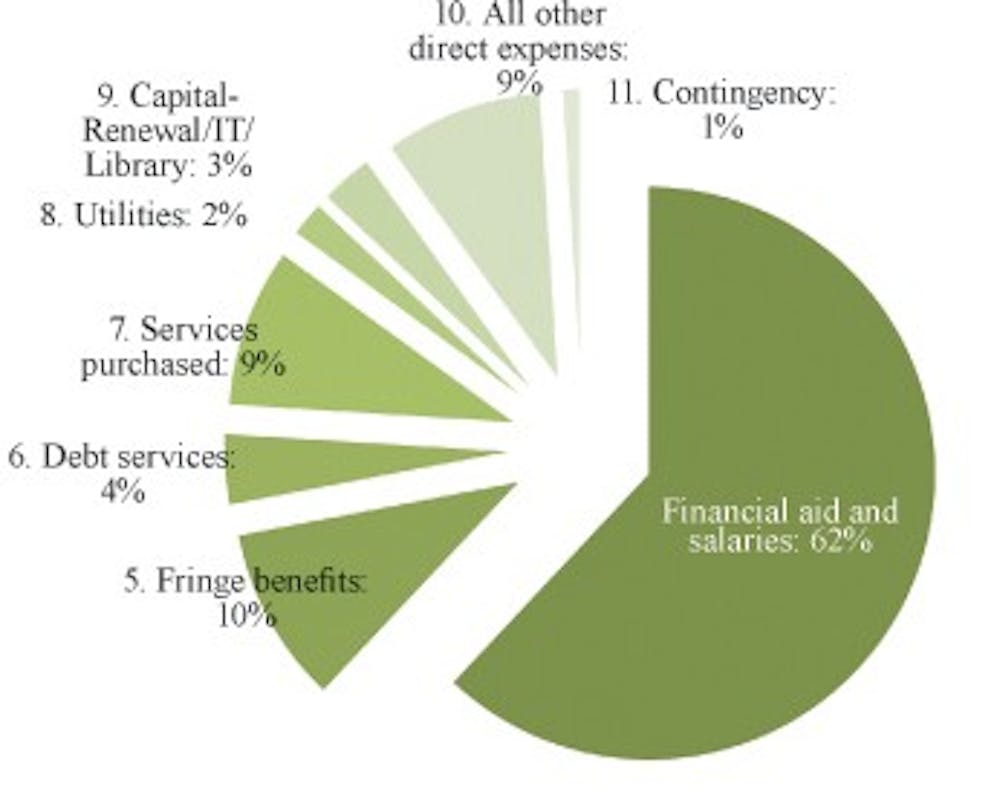A Beacon primer on where UP gets money and how UP spends it
(The Beacon)
By Caitlin Yilek, Staff Writer -- yilek12@up.edu
Every year, the increasing cost of tuition and other college expenses burns a hole in the wallets of students and their parents.
UP students should expect a 4.5 percent increase in tuition for the upcoming academic year. Room and board rates are also going up, with increases ranging from 2.8 percent to 4.6 percent, depending on variables such as meal plans and number of roommates.
Despite the increases, tuition and payments for room and board still do not fully cover UP's costs, according to the administration.
So where does the rest come from?
And why does everything cost so much?
The Beacon breaks it down for you.
Where UP gets its money
1. At 75 percent of UP's revenue, tuition is UP's largest source of revenue, according to data provided by Denis Ransmeier, vice president for Financial Affairs.
With the 4.5 percent increase in tuition, according to Ransmeier, UP is expected to take in $120 million from tuition during the next academic year. This is nearly $8.5 million more than this year.
2. Room and board is 11 percent of UP's revenue.
A standard room in the residence halls will cost $5,660 during the upcoming academic year. The average cost of a meal plan is a little more than $4,700.
3. Though student fees are only 2 percent of UP's revenue, UP will take in over $3.5 million during the next academic year from the professional tuition fee and the ASUP student government fee.
The ASUP government fee is $70 each semester per student. The money primarily goes toward CPB events and student clubs.
Fees also include the professional tuition fee for classes in the business, nursing, engineering and education schools.
4. Off-campus programs, such as Studies Abroad, make up 4 percent of UP's revenue.
5. UP takes in 2 percent of its revenue from contributions or annual gifts made by alumni and friends of the University.
6. Another 2 percent of UP's revenue is from an endowment draw, which is the interest made from gifts and contributions.
7. Grants and contracts make up 1 percent of UP's revenue. These grants and contracts are usually for research from foundations or government agencies, according to Ransmeier.
8. UP takes in 3 percent of its revenue from miscellaneous sources such as parking tickets, library fees and ticket sales.
How UP spends its money
1. UP's largest expense is financial aid. Thirty-four percent of UP's income is spent on financial aid.
"This means that 34 cents of every dollar spent goes toward student scholarships and grants," Ransmeier said.
This 34 percent does not include student loans.
2-3. The second largest UP expense is staff salaries, followed closely by faculty salaries. According to Ransmeier, UP employs 393 full-time and 60 part-time staff as well as 205 full-time and 116 part-time faculty.
4. Student salaries, such as work-study positions, make up 2 percent of UP's expenses.
5. Fringe benefits are 10 percent of UP's expenses. These benefits include retirement, tuition remission, payroll taxes and health insurance for employees.
6. Four percent of UP's expenses are devoted to paying back any debt the University has accumulated.
"(This is) entirely for new buildings and remodels that were paid for with a combination of gifts and bonds, or borrowing," Ransmeier said.
7. Nine percent of the budget is allocated for services such as Bon Appétit. There are also other expenses associated with Studies Abroad and off-campus printing, Ransmeier said.
8. The cost of utilities makes up 2 percent of UP's expenses. The utilities include electricity, natural gas, water, sewer and solid waste disposal.
9. The capital-renewal/IT/library expense includes the renewal of buildings and equipment, wear and tear, the Library's collection and technology.
10. All other direct expenses paid by UP include travel, office and custodial supplies, postage, etc.
11. The contingency expense is the University's emergency fund.
"It's for emergencies, unforeseen expenses or events, or if enrollment falls short of what is projected for the budget or if financial aid is over awarded," Ransmeier said.
(The Beacon)
(The Beacon)
(The Beacon)








